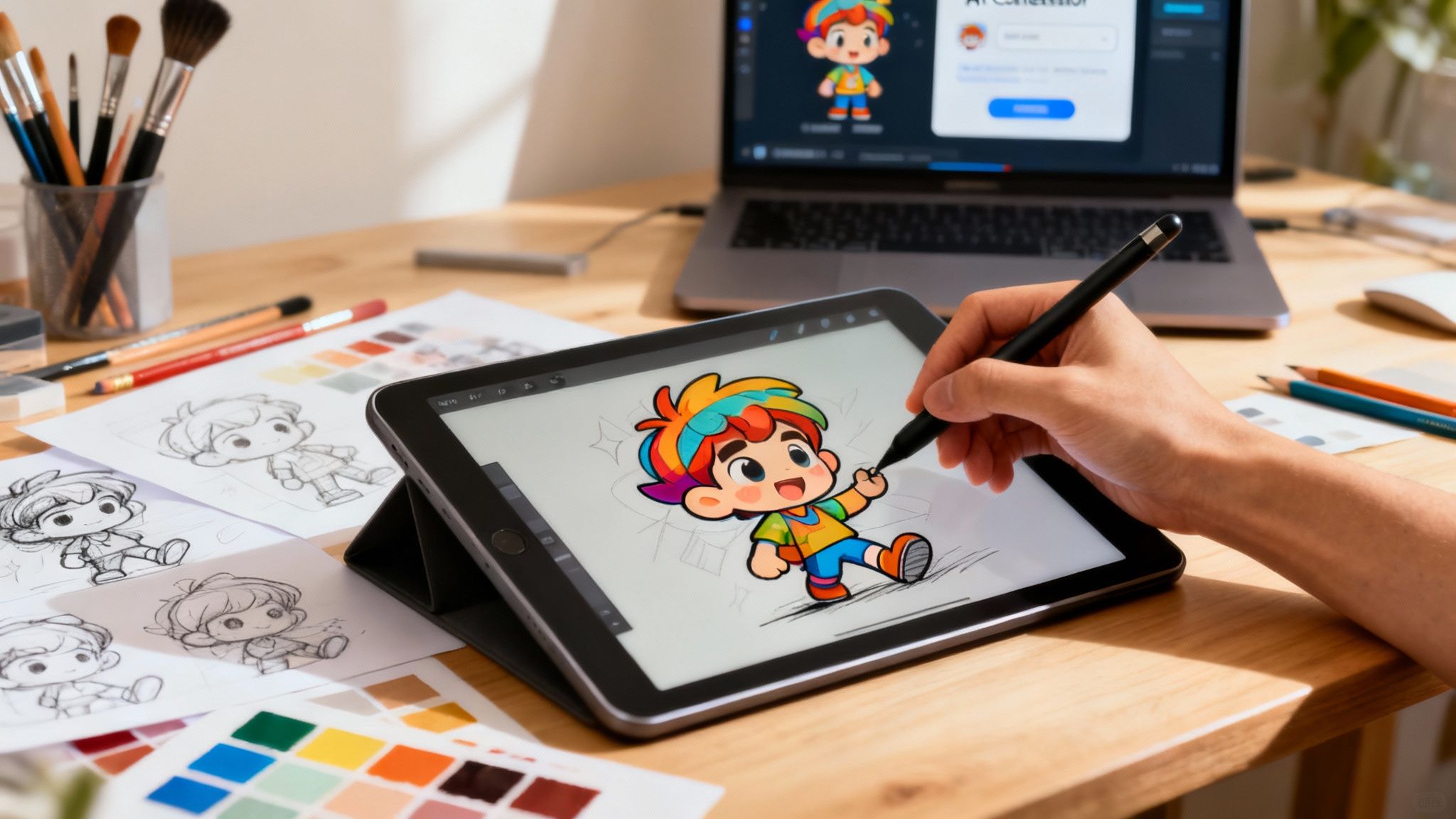
Every creator, marketer, and digital agency faces the same recurring challenge: the relentless demand for fresh, engaging content. Staring at a blank content calendar can be daunting, leading to burnout and repetitive posts that fail to capture audience attention. The pressure to innovate while maintaining a consistent publishing schedule is immense, making content creation feel like a chore rather than a creative endeavor. This constant search for the next great content creation idea can drain resources and stall momentum.
This article is your solution. We’re moving beyond the basics to break down 10 powerful frameworks for generating high-impact material that resonates with your audience. Each strategy is designed to be actionable, helping you transform your content workflow from a stressful task into a strategic, creative powerhouse. We will also explore how AI tools like Media Workbench can help you execute these concepts faster and more effectively, ensuring you never run out of compelling ideas again.
1. Interactive Storytelling
Interactive storytelling transforms content from a monologue into a dialogue. Instead of passively consuming information, your audience actively participates, influencing the narrative through their choices. This content creation idea boosts engagement by giving users a sense of agency and making the experience uniquely personal. By clicking, choosing, or inputting information, each user carves their own path through the content, leading to a more memorable and impactful interaction.
This method is highly effective for explaining complex processes, launching a new product in a novel way, or creating deeply personalized user journeys. For example, a digital marketing agency could create an interactive quiz titled "What's Your Content Marketing Superpower?" that guides users through questions about their goals and provides a tailored content strategy at the end. The core benefit is turning consumption into a co-creation experience.
How to Implement Interactive Storytelling
- Map the Narrative: Before writing or designing, use a flowchart tool to map out every possible story branch. Clearly define each decision point and its corresponding consequences to ensure a cohesive experience.
- Start Simple: Begin with basic mechanisms like polls on Instagram Stories or simple "choose your path" blog post structures. As you gather data, you can introduce more complex elements.
- Prioritize Value: Every narrative pathway, regardless of the choices made, should provide a satisfying and valuable conclusion. Avoid creating "wrong" paths that penalize the user.
The following infographic illustrates the fundamental workflow for structuring an interactive narrative, a key process for this content creation idea.

This process highlights how a well-structured plan, from initial branching to final outcomes, is essential for a seamless and engaging user experience.
2. User-Generated Content Campaigns
User-Generated Content (UGC) campaigns transform your audience from passive consumers into active brand advocates. Instead of creating content yourself, you inspire customers to create and share it on your behalf. This content creation idea leverages authenticity and social proof, as people trust recommendations from peers far more than they trust traditional advertising. By encouraging users to share their experiences, you build a powerful library of genuine, relatable content that boosts credibility and engagement.
This strategy is exceptionally effective for building community and generating a high volume of diverse content at a low cost. For instance, a software startup could launch a campaign asking users to share short video testimonials of their favorite feature in action, using a branded hashtag like #MyWorkflowWin. The best submissions get featured, providing social proof and relatable use cases. The core benefit is outsourcing content creation to your most passionate fans.
How to Implement User-Generated Content Campaigns
- Create Simple Guidelines: Establish clear and easy-to-follow rules for participation. Define what kind of content you're looking for and how users can submit it, using a unique, memorable branded hashtag.
- Offer Meaningful Incentives: Motivate your audience to participate by offering valuable rewards. This could be anything from prizes and discounts to simply featuring the best submissions on your official channels, providing recognition.
- Engage and Amplify: Actively monitor submissions, engage with participants by liking and commenting, and regularly showcase the best content. This validates your community's effort and encourages more people to join in.
3. Behind-the-Scenes Content
Behind-the-scenes content humanizes your brand by revealing the processes, people, and unpolished moments that typically remain hidden. Instead of just presenting a final product, this approach builds trust and connection by showing the authentic work that goes into it. This content creation idea pulls back the curtain, making your brand more relatable and transparent.

This method is highly effective for building community, demonstrating craftsmanship, and fostering brand loyalty. A freelance graphic designer could share time-lapse videos of their design process or post an Instagram Story walking through a client brief (with permission). This not only showcases their skill but also educates potential clients on the value they provide. The core benefit is transforming your audience from simple consumers into engaged fans who feel connected to your brand’s journey and values.
How to Implement Behind-the-Scenes Content
- Document, Don't Stage: Capture genuine moments as they happen. Use mobile devices for spontaneous, authentic footage that feels less like a polished advertisement and more like an insider's view.
- Showcase Your Team: Feature team members from all levels, not just executives or founders. Highlighting the people behind the brand adds a powerful human element that audiences appreciate.
- Embrace Imperfection: Share the challenges, mistakes, and learning moments. Documenting failures and how you overcame them makes your brand more authentic and trustworthy.
The following video from Gary Vaynerchuk demonstrates how to effectively document your process rather than creating staged content, a key principle for this content creation idea.
This approach emphasizes that capturing the genuine, everyday journey is often more powerful than producing a perfect, but impersonal, final cut.
4. Educational Micro-Learning Content
Educational micro-learning content breaks down complex topics into digestible, bite-sized lessons. Instead of long-form tutorials, this content creation idea delivers focused knowledge in short, accessible formats, catering to short attention spans and busy schedules. This approach maximizes learning retention by presenting one core concept at a time, making it easier for audiences to absorb and apply new skills or information.

This method is ideal for building authority and providing continuous value. A marketing consultant could create a series of 60-second "Marketing Minute" videos for TikTok, where each video explains one specific marketing term or shares a quick tip for improving ad copy. This establishes them as a go-to expert without requiring a large time commitment from their audience. The key benefit is establishing your brand as an indispensable educational resource in your niche.
How to Implement Educational Micro-Learning Content
- Focus on a Single Takeaway: Each piece of micro-content should teach one specific skill, answer one question, or explain one concept. Avoid overwhelming the audience with too much information at once.
- Use Visuals Heavily: Leverage short videos, infographics, GIFs, or annotated screenshots to demonstrate concepts quickly and clearly. Visuals significantly improve comprehension and retention in short formats.
- Create a Content Series: Structure your micro-lessons into a logical sequence or series. This encourages repeat engagement as users follow along to build their knowledge progressively over time.
5. Live Interactive Streaming
Live interactive streaming transforms content from a broadcast into a shared experience. Instead of just watching a pre-recorded video, your audience participates in real-time through comments, reactions, and live polls. This content creation idea builds a powerful sense of community and authenticity by allowing for spontaneous, unscripted moments. By directly engaging with viewers as the action unfolds, creators foster genuine connections that polished, pre-produced content often cannot replicate.
This method is ideal for product launches, Q&A sessions with experts, or live tutorials where immediate feedback is valuable. For example, a content marketing agency could host a monthly live "Content Clinic" on LinkedIn, where they review audience-submitted blog posts and offer real-time feedback. This provides immense value and showcases their expertise. For creators looking to streamline their promotional efforts around live events, exploring social media automation software can help manage announcements and follow-ups efficiently.

How to Implement Live Interactive Streaming
- Establish a Schedule: Consistency is crucial. Stream at the same time and day each week to build a regular audience that knows when to tune in.
- Prepare Key Points: Have a loose outline of topics to cover to maintain momentum, but leave ample room for spontaneous interaction and audience-led detours.
- Acknowledge Your Audience: Actively read and respond to comments by name. This makes viewers feel seen and encourages more participation, turning viewers into active community members.
- Promote Extensively: Announce your upcoming stream across all your social media platforms, in your email newsletter, and on your website to maximize viewership.
6. Data Storytelling and Visualization
Data storytelling and visualization transforms raw data from a complex set of numbers into a compelling and understandable narrative. Instead of simply presenting statistics, this content creation idea weaves them into a story that highlights trends, insights, and key takeaways. This approach makes dense information accessible and engaging for a broader audience, turning potentially dry facts into memorable and persuasive content. By combining analytical rigor with creative design, you can make a powerful impact.
This method is exceptionally effective for demonstrating industry trends, showcasing research findings, or personalizing user experiences with their own data. A startup that helps creators track their income could publish an annual industry report visualizing trends in creator earnings, platforms, and monetization strategies, establishing themselves as a leading authority. The core benefit is converting abstract data into a clear, relatable, and visually appealing story that drives understanding and engagement.
How to Implement Data Storytelling
- Start with a Hypothesis: Before designing any visuals, define the central story or question your data will answer. A clear narrative focus ensures your visualizations serve a purpose beyond just looking good.
- Maintain Visual Consistency: Use a consistent color scheme, typography, and design elements throughout your visualization. This creates a cohesive and professional look that makes the information easier to follow.
- Verify and Cite Sources: Build credibility by meticulously verifying all data and clearly citing your sources. Transparency in your methodology is crucial for audience trust.
Exploring how to use AI for marketing can further enhance this process, helping you analyze datasets and generate narrative ideas more efficiently. Learn more about leveraging AI for your marketing strategies on mediaworkbench.ai.
7. Collaborative Content Creation
Collaborative content creation is a strategy that involves partnering with other creators, brands, or industry experts to produce shared content. This powerful content creation idea pools resources and audiences, allowing you to tap into a new community while reinforcing your own credibility. By joining forces, both parties gain exposure to an engaged audience that already trusts the collaborator, providing a warm introduction that is difficult to achieve alone.
This approach is highly effective for accelerating growth and producing diverse, high-value content. A solopreneur specializing in email marketing could co-author a comprehensive guide on lead generation with a freelance SEO expert. Each promotes the guide to their respective audiences, doubling the reach and providing more holistic value. For more insights on streamlining your creative workflow for such projects, explore the best AI tools for content creation.
How to Implement Collaborative Content Creation
- Choose Aligned Partners: Seek collaborators whose audience demographics and brand values mirror your own. A successful partnership relies on authentic alignment, not just audience size.
- Define Clear Roles: Before starting, establish a clear agreement outlining each party's responsibilities, deliverables, deadlines, and promotional commitments to prevent miscommunication.
- Cross-Promote Extensively: The collaboration's success hinges on promotion. Ensure both parties commit to sharing the final content across all their primary channels, including social media, newsletters, and websites.
👉 Try MediaWorkbench.ai for free – schedule your posts and generate AI content in one place!
8. Seasonal and Trending Content
Seasonal and trending content taps into the current cultural conversation, making your brand timely and relevant. Instead of creating in a vacuum, this content creation idea leverages holidays, current events, and viral topics to connect with what your audience is already thinking about and discussing. By aligning your message with these moments, you can capture immediate attention, drive social sharing, and demonstrate that your brand is in touch with the world.
This approach is powerful for boosting short-term engagement and increasing brand visibility. During the holiday shopping season, a marketing agency could create a helpful guide on "Last-Minute Holiday Campaign Ideas for Small Businesses," providing immediate, actionable value. The key is to be agile and authentic, joining conversations where your brand can add value without feeling forced. Integrating this into your broader plan is a core tenet of modern content marketing strategy examples.
How to Implement Seasonal and Trending Content
- Monitor Trends: Use social listening tools like Brandwatch or even the built-in trending sections on social platforms to stay ahead of emerging topics. Act quickly, as the window of relevance is often very short.
- Plan Ahead: For predictable events like holidays or seasons, plan your content well in advance. Leveraging a social media holiday calendar can help you organize and prepare high-quality, relevant posts.
- Stay On-Brand: Ensure your contribution to a trend aligns with your brand's voice and values. Jumping on a topic that doesn't fit your identity can feel inauthentic and confuse your audience.
9. Repurposing and Content Recycling
Repurposing and content recycling is a strategic approach that maximizes the value of every piece you create. Instead of producing one-off assets, this content creation idea involves transforming existing content into multiple formats and adapting it for different platforms and audiences. This not only saves significant time and resources but also reinforces your core message across various channels, creating a cohesive brand experience.
This method is highly effective for building a strong content engine and ensuring a consistent presence online. A digital marketer could take their most popular long-form blog post about "The Ultimate Guide to SEO" and transform it into a shareable infographic, a series of ten quick-tip Instagram carousels, a short explainer video for YouTube, and talking points for a podcast episode. The core benefit is amplifying your reach without reinventing the wheel.
How to Implement Repurposing and Content Recycling
- Create a Content Matrix: Map your core content pillars to various formats (e.g., video, blog, infographic, carousel) and platforms (e.g., Instagram, LinkedIn, YouTube, blog). This provides a clear roadmap for what to create and where to distribute it.
- Adapt, Don't Just Copy: Meaningfully adapt your content for each platform’s unique audience and format requirements. A data-heavy blog section should become a visual chart for Instagram, not just a block of text.
- Update and Refresh: When recycling older content, ensure all statistics, examples, and information are current. This adds fresh value and improves the credibility of the repurposed asset.
10. Community-Driven Content Formats
Community-driven content formats shift the focus from your brand to your audience, making them co-creators. Instead of producing all content internally, you empower your community members to contribute through Q&A sessions, forums, challenges, and member spotlights. This content creation idea generates a steady stream of authentic, user-generated material while fostering a powerful sense of belonging and loyalty. By putting your audience at the center, you validate their expertise and build a self-sustaining content ecosystem.
This strategy is exceptionally effective for building an engaged following and gathering customer insights. A SaaS company could create a dedicated Slack channel or forum where users share their unique workflows and success stories. The company can then feature the most innovative user stories in their official blog or newsletter, providing social proof and inspiring other users. The core benefit is transforming passive consumers into active participants who are invested in your brand’s success.
How to Implement Community-Driven Content Formats
- Establish Clear Guidelines: Create and communicate clear rules for participation. This ensures that all contributions are constructive, relevant, and align with your community’s values, preventing spam and maintaining a positive environment.
- Create Structured Opportunities: Don’t just wait for content to appear. Actively create structured formats like weekly Q&A threads, monthly challenges with specific prompts, or a "member of the week" spotlight to encourage consistent participation.
- Recognize and Reward Contributors: Regularly feature and celebrate top contributors. A simple shout-out, a badge, or a small prize can go a long way in making members feel valued and motivated to continue sharing their insights.
From Ideas to Impact
We've covered ten powerful strategies for your next content creation idea, moving from passive broadcasting to active community engagement. The key takeaway is that true success lies not just in the initial concept, but in the strategic execution. By implementing interactive storytelling, leveraging user-generated content, and offering genuine behind-the-scenes glimpses, you build trust and foster loyalty. These approaches transform your content from a monologue into a dialogue, making your audience feel seen, heard, and valued.
Ready to put these strategies into action? AI-powered tools can be your ultimate accelerator. Instead of spending hours scripting, designing, and scheduling, platforms like Media Workbench can handle the heavy lifting, freeing you to focus on creative strategy. Imagine transforming a single data report into an infographic, a video script, and a week’s worth of social media posts in minutes. To efficiently turn your ideas into action, explore the top AI video generators for 2025. Armed with these strategies and the power of AI, you can execute brilliant ideas with unprecedented speed and impact.
Ready to stop juggling tools and start creating? Media Workbench AI consolidates text generation, image creation, scheduling, and analytics into one seamless platform. Transform your best content creation ideas into finished assets faster than ever by visiting Media Workbench AI and starting your free trial today.

